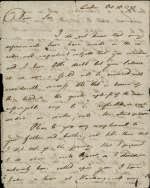Monday, October 14, 2013
JOSEPH PRIESTLEY CORRESPONDENCE located in USA - including letter to THOMAS WEDGWOOD
Tuesday, October 8, 2013
The Roundhouse at Etruria, a bit of Wedgwood history
From our favorite UK newsmedia, The Sentinel, we bring you this interesting historical article. The link to the original article is: http://www.thisisstaffordshire.co.uk/Way-roundhouse-Etruria/story-19890891-detail/story.html#axzz2hBwPQSGk but there is an annoying ad with sound. You can click on the symbol in the lower left of the ad and it should shut off the sound. The article below is from that link sans sound:

Way We Were: The roundhouse at Etruria
Saturday, October 05, 2013
MADAM, – With reference to Micheal
Pritchard's picture [above] of the Roundhouse at Etruria in The Way We Were on
September 21.
This originally was one of a pair
that flanked each side of the facade of the Etruria factory that Josiah
Wedgwood completed in June 1769.
A simple sketch of these
roundhouses by Josiah, along with other styles, was included in a letter he
wrote to his business partner Thomas Bentley on Christmas Eve 1767.
One unusual feature of the old
factory was that the facade faced the canal rather than the main road.
This was so that important visitors
received by Josiah at Etruria Hall would have had a view of the factory before
being shown around it.
The roundhouse that did not survive
housed one of the ornamental ware glost ovens. However, the use to which the
surviving one was put is less certain and suggestions include a hovel for
another oven, a grinding mill and a stable.
By the 1850s plans were drawn up to
have the building converted into a cottage and rented to one of the Wedgwood
employees, although this never materialised.
Even before the 20th century the
Wedgwood factory had suffered from subsidence due to the extensive mining in
the area.
This caused problems with drains,
the constant flooding of cellars during wet weather, and the sagging and
buckling of the tracks of the newly installed tunnel kilns.
In addition to subsidence, air
pollution was another problem.
Smoke from trains climbing the
gradient of the loop line and iron filings drifting up from Shelton Bar were a
constant cause of ware being speckled.
The question of finding a new
location for the factory was first addressed at a meeting of the board of
directors on November 26, 1935.
The proposal to relocate was
announced to the workforce at a lunchtime meeting in the canteen on Friday May
14, 1936.
The news was broken by Josiah
Wedgwood V, who confirmed that due to the severity of subsidence relocation was
inevitable, and that the company had purchased an estate at Barlaston where the
new factory would be built.
He spoke of the ideal working
conditions that the new factory would offer, the sporting facilities and the
estate of houses that would be built, painting a promising picture to the
workforce.
The huge task of transferring the
works from Etruria was accomplished in two halves.
Only the earthenware and Jasper
departments moved to Barlaston in 1940.
China production remained at the
old factory until 1947 and accounted for a large proportion of the workforce.
The majority of the old factory not
used for china production was utilised for the storage of moulds and dismantled
machinery. Certain areas had been leased out to other companies for storage
premises and included the Dunlop Rubber Company and Shelton Bar.
From the beginning of the 50s the
old Wedgwood factory had gone through several occupants, steadily becoming more
dilapidated.
During the early 60s it suffered
from vandalism. By this time the factory was in the hands of St Quentin
Properties which planned to demolish those parts of the works not deemed by the
Ministry of Housing as being of particular historic interest, and to use the
land as a light industrial estate.
The original intention was to
preserve the original office block of 1769, two bottle kilns behind the main
building and the roundhouse immediately to one side of it.
Attempts to raise both sufficient
interest and capital failed, however, and demolition of the Wedgwood factory
took place during September 1965.
All was cleared away, the only
building spared being the Roundhouse that still exists on the site today.
KEVIN SALT Longton
Subscribe to:
Comments (Atom)















